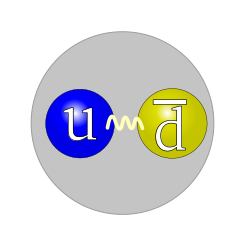Pi-meson

The quark structure of the pion.
|
|
| Composition |
π+ : u d π0 : u u or d d π− : d u |
|---|---|
| Statistics | Bosonic |
| Interactions | Strong, Weak, Electromagnetic and Gravity |
| Symbol |
π+ , π0 , and π− |
| Theorized | Hideki Yukawa (1935) |
| Discovered | César Lattes, Giuseppe Occhialini (1947) and Cecil Powell |
| Types | 3 |
| Mass |
π± : 139.57018(35) MeV/c2 π0 : 134.9766(6) MeV/c2 |
| Electric charge |
π+ : +1 e π0 : 0 e π− : −1 e |
| Spin | 0 |
| Parity | −1 |
In particle physics, a pion (or a pi meson, denoted with the Greek letter pi:
π
) is any of three subatomic particles:
π0
,
π+
, and
π−
. Each pion consists of a quark and an antiquark and is therefore a meson. Pions are the lightest mesons (and, more generally, the lightest hadrons), because they are composed of the lightest quarks (the u and d quarks). They are unstable, with the charged pions
π+
and
π−
decaying with a mean lifetime of 26 nanoseconds (2.6×10−8 seconds), and the neutral pion
π0
decaying with a much shorter lifetime of 8.4×10−17 seconds. Charged pions most often decay into muons and muon neutrinos, while neutral pions generally decay into gamma rays.
...
Wikipedia
